The global di-n-octyl sulfide market, valued at USD 76.6 million in 2025, is projected to reach USD 128.4 million by 2035, expanding at a CAGR of 5.3% and adding USD 51.8 million in absolute value over the forecast horizon. A year-on-year (YoY) analysis highlights a steady and incremental growth pattern, consistent with its role as a niche yet essential chemical intermediate. From 2025 to 2026, the di-n-octyl sulfide market is expected to cross the USD 80 million threshold, marking the beginning of a growth cycle powered by pharmaceutical and specialty chemical applications. By 2027, as demand strengthens in high-purity synthesis for catalytic processes and industrial formulations, YoY expansion is expected to consolidate around the 5% mark. This moderate pace indicates stability rather than sharp volatility, suggesting that consumption is linked more to ongoing structural trends in advanced materials and synthesis techniques than to cyclical fluctuations.
Moving into the 2028–2030 period, the di-n-octyl sulfide market is anticipated to accelerate marginally, reaching approximately USD 100 million by the end of the decade. YoY growth during these years is expected to stabilize in the 5.3% to 5.5% range, reinforced by the broader adoption of sulfur-based intermediates in pharmaceutical manufacturing and chemical R&D initiatives. Increasing reliance on di-n-octyl sulfide in precision applications contributes to predictable demand, with industrial processing facilities incorporating these compounds into upgraded formulations. The turn of the decade signals a significant milestone, as growth during this stage represents close to 45% of the decade’s absolute market expansion, demonstrating how early momentum creates the base for long-term scale.
Between 2031 and 2035, the YoY trajectory continues its steady climb, with the di-n-octyl sulfide market expected to add roughly USD 28.4 million in the latter half of the period. Growth rates hover around the CAGR average, ensuring a consistent climb toward the USD 128.4 million mark by 2035. This phase is marked by wider adoption in high-value synthesis, increased penetration into specialty chemical markets, and enhanced regulatory approvals that validate its use in pharmaceutical-grade applications. Efficiency gains in production processes also allow suppliers to maintain competitive pricing, supporting broader accessibility across regions. The YoY expansion in this period underscores the resilience of the market, as it maintains demand despite possible macroeconomic pressures or shifts in raw material costs.
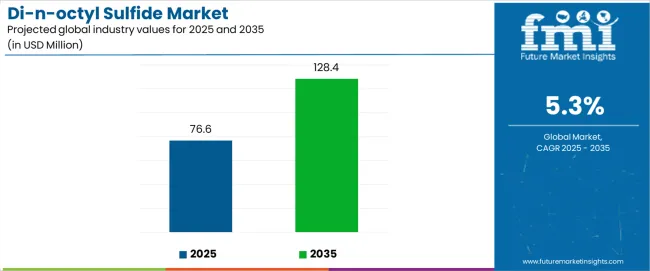
Between 2025 and 2030, the Di-n-octyl sulfide market is projected to expand from USD 76.6 million to USD 98.7 million, resulting in a value increase of USD 22.1 million, which represents 42.7% of the total forecast growth for the decade. This phase of development will be shaped by increasing demand for pharmaceutical intermediates, rising chemical processing activity enabling advanced synthesis techniques, and growing availability of high-purity chemical compounds across research laboratories and industrial manufacturing facilities.
Between 2030 and 2035, the di-n-octyl sulfide market is forecast to grow from USD 98.7 million to USD 128.4 million, adding another USD 29.7 million, which constitutes 57.3% of the overall ten-year expansion. This period is expected to be characterized by the advancement of specialized synthesis processes, the integration of quality control systems for chemical purity verification, and the development of premium chemical grades across diverse pharmaceutical applications. The growing emphasis on process optimization and chemical waste reduction will drive demand for advanced chemical varieties with enhanced purity characteristics, improved stability profiles, and superior performance attributes.
Between 2020 and 2024, the Di-n-octyl sulfide market experienced steady growth, driven by increasing pharmaceutical research activity and growing recognition of sulfur compounds' effectiveness in delivering consistent chemical synthesis outcomes across medicinal chemistry and industrial processing applications. The di-n-octyl sulfide market developed as chemical manufacturers recognized the potential for specialized sulfur compounds to deliver operational efficiency while meeting modern requirements for chemical purity and high-quality synthesis operations. Technological advancement in chemical purification and synthesis design began emphasizing the critical importance of maintaining chemical consistency while enhancing process reliability and improving material utilization rates.
| Metric | Value |
|---|---|
| Estimated Value in (2025E) | USD 76.6 million |
| Forecast Value in (2035F) | USD 128.4 million |
| Forecast CAGR (2025 to 2035) | 5.30% |
From 2030 to 2035, the di-n-octyl sulfide market is forecast to grow from USD 98.7 million to USD 128.4 million, adding another USD 29.7 million, which constitutes 57.3% of the overall ten-year expansion. This period is expected to be characterized by the advancement of digital quality monitoring systems, the integration of automated purification processes for manufacturing efficiency, and the development of specialized chemical grades for enhanced synthesis applications. The growing emphasis on chemical traceability and operational precision will drive demand for premium varieties with enhanced analytical credentials, improved compatibility options, and superior functionality characteristics.
Between 2020 and 2024, the Di-n-octyl sulfide market experienced robust growth, driven by increasing awareness of chemical synthesis benefits and growing recognition of sulfur compounds' effectiveness in supporting efficient research operations across pharmaceutical laboratories and specialty chemical manufacturing services. The di-n-octyl sulfide market developed as users recognized the potential for specialized chemicals to deliver productivity advantages while meeting modern requirements for consistent synthesis quality and reliable process performance. Technological advancement in chemical manufacturing processes and quality assurance systems began emphasizing the critical importance of maintaining purity standards while extending chemical shelf life and improving customer satisfaction across diverse synthesis applications.
Market expansion is being supported by the increasing global demand for specialized chemical intermediates and the corresponding shift toward high-performance sulfur compounds that can provide superior operational characteristics while meeting user requirements for chemical purity and cost-effective synthesis processes. Modern pharmaceutical researchers are increasingly focused on incorporating chemical systems that can enhance synthesis efficiency while satisfying demands for consistent, precisely controlled reaction outcomes and optimized material consumption practices. Di-n-octyl sulfide's proven ability to deliver synthesis efficiency, process reliability, and diverse application possibilities makes it an essential component for pharmaceutical researchers and quality-conscious chemical professionals.
The growing emphasis on precision synthesis and process optimization is driving demand for high-performance chemical systems that can support distinctive synthesis outcomes and comprehensive process protection across pharmaceutical research, industrial processing, and specialty chemical applications. User preference for chemicals that combine functional excellence with operational flexibility is creating opportunities for innovative implementations in both traditional and emerging synthesis applications. The rising influence of automated synthesis processes and advanced chemical technologies is also contributing to increased adoption of specialized chemicals that can provide authentic performance benefits and reliable operational characteristics.
The di-n-octyl sulfide market is segmented by purity grade, application, synthesis method, end-user industry, and region. By purity grade, the di-n-octyl sulfide market is divided into high purity grade ≥97%, standard purity grade <97%, research grade, and technical grade. Based on application, the di-n-octyl sulfide market is categorized into pharmaceutical intermediates, industrial processing, chemical synthesis, research applications, and others. By synthesis method, the di-n-octyl sulfide market includes direct synthesis, catalytic synthesis, and modified synthesis processes. By end-user industry, the di-n-octyl sulfide market encompasses pharmaceutical companies, chemical manufacturers, research institutions, and specialty chemical producers. Regionally, the market is divided into North America, Europe, Asia Pacific, Latin America, Middle East & Africa, and other regions.
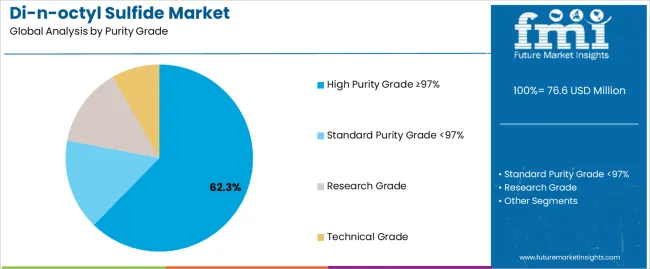
The high purity grade ≥97% segment is projected to account for 62.3% of the Di-n-octyl sulfide market in 2025, reaffirming its position as the leading purity category. Pharmaceutical researchers and chemical professionals increasingly utilize high purity grade chemicals for their superior quality characteristics, established reliability standards, and essential functionality in diverse synthesis applications across multiple project types. High purity grade chemicals' proven performance characteristics and established cost-effectiveness directly address user requirements for reliable synthesis operations and optimal chemical precision in pharmaceutical applications.
This purity segment forms the foundation of modern chemical synthesis performance patterns, as it represents the chemical category with the greatest operational impact potential and established compatibility across multiple synthesis systems. Business investments in advanced purification technology and quality optimization continue to strengthen adoption among quality-conscious researchers. With users prioritizing synthesis consistency and chemical reliability, high purity grade chemicals align with both productivity objectives and quality requirements, making them the central component of comprehensive synthesis strategies.
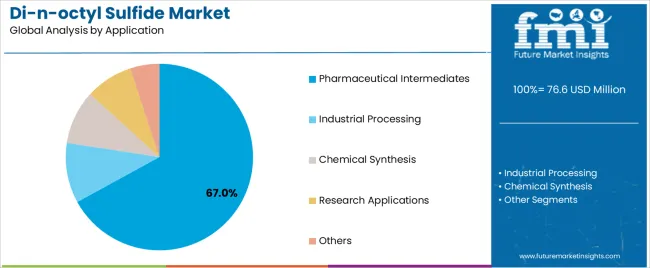
Pharmaceutical applications are projected to represent 67.0% of the Di-n-octyl sulfide market in 2025, underscoring their critical role as the primary application for quality-focused researchers seeking superior synthesis efficiency benefits and enhanced research completion credentials. Pharmaceutical researchers and chemical professionals prefer pharmaceutical applications for their established research volumes, proven market demand, and ability to maintain exceptional synthesis quality while supporting versatile chemical requirements during diverse research projects. Positioned as essential applications for performance-conscious researchers, pharmaceutical offerings provide both operational excellence and competitive positioning advantages.
The segment is supported by continuous improvement in synthesis technology and the widespread availability of established research standards that enable quality assurance and premium positioning at the pharmaceutical level. Pharmaceutical companies are optimizing chemical selections to support research differentiation and competitive development strategies. As synthesis technology continues to advance and researchers seek efficient synthesis methods, pharmaceutical applications will continue to drive market growth while supporting business development and research satisfaction strategies.
The Di-n-octyl sulfide market is advancing rapidly due to increasing chemical synthesis consciousness and growing need for precision chemical solutions that emphasize superior performance outcomes across pharmaceutical segments and industrial applications. The di-n-octyl sulfide market faces challenges, including competition from alternative chemical intermediates, synthesis process complexities, and chemical cost pressures affecting operational economics. Innovation in analytical monitoring integration and advanced purification methods continues to influence market development and expansion patterns.
The growing adoption of Di-n-octyl sulfide in pharmaceutical research and chemical development is enabling researchers to develop synthesis strategies that provide distinctive efficiency benefits while commanding competitive positioning and enhanced research completion characteristics. Pharmaceutical applications provide superior synthesis consistency while allowing more sophisticated quality control features across various research categories. Users are increasingly recognizing the operational advantages of chemical positioning for premium synthesis outcomes and efficiency-conscious research integration.
Modern Di-n-octyl sulfide manufacturers are incorporating advanced analytical technologies, digital purity control systems, and automated quality tracking to enhance operational precision, improve chemical stability, and meet commercial demands for intelligent chemical solutions. These systems improve operational effectiveness while enabling new applications, including predictive quality programs and performance optimization protocols. Advanced monitoring integration also allows researchers to support productivity leadership positioning and quality assurance beyond traditional synthesis operations.
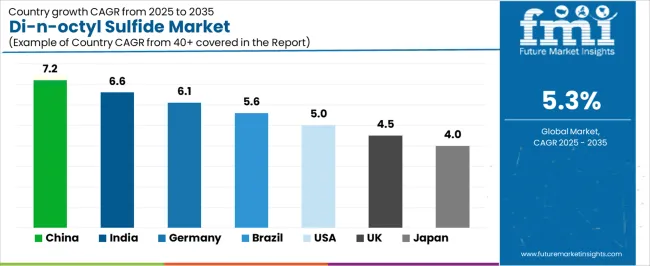
| Country | CAGR (2025-2035) |
|---|---|
| China | 7.2% |
| India | 6.6% |
| Germany | 6.1% |
| Brazil | 5.6% |
| USA | 5.0% |
| UK | 4.5% |
| Japan | 4.0% |
The Di-n-octyl sulfide market is experiencing robust growth globally, with China leading at a 7.2% CAGR through 2035, driven by the expanding pharmaceutical industry, growing chemical manufacturing requirements, and increasing adoption of specialized synthesis systems. India follows at 6.6%, supported by rising research development, expanding chemical sector, and growing acceptance of efficient synthesis solutions. Germany shows growth at 6.1%, emphasizing established chemical capabilities and comprehensive synthesis technology development. Brazil records 5.6%, focusing on pharmaceutical expansion and chemical processing growth. The USA demonstrates 5.0% growth, prioritizing advanced synthesis technologies and process optimization.
The report covers an in-depth analysis of 40+ countries, top-performing countries are highlighted below.
Revenue from Di-n-octyl sulfide consumption and sales in China is projected to exhibit exceptional growth with a CAGR of 7.2% through 2035, driven by the country's rapidly expanding pharmaceutical sector, favorable government policies toward chemical development, and initiatives promoting advanced synthesis technologies across major industrial regions. China's position as a leading chemical manufacturing hub and increasing focus on specialized chemical systems are creating substantial demand for high-quality Di-n-octyl sulfide in both domestic and export markets. Major pharmaceutical companies and chemical manufacturers are establishing comprehensive synthesis capabilities to serve growing demand and emerging market opportunities.
Revenue from Di-n-octyl sulfide products in India is expanding at a CAGR of 6.6%, supported by rising pharmaceutical investment, growing chemical development, and expanding research capabilities. The country's developing pharmaceutical sector and increasing commercial investment in advanced synthesis technologies are driving demand for Di-n-octyl sulfide across both traditional and modern synthesis applications. International chemical companies and domestic distributors are establishing comprehensive operational networks to address growing market demand for quality chemicals and efficient synthesis solutions.
Revenue from Di-n-octyl sulfide products in Germany is projected to grow at a CAGR of 6.1% through 2035, supported by the country's mature chemical sector, established synthesis standards, and leadership in chemical technology. Germany's sophisticated pharmaceutical infrastructure and strong support for advanced synthesis systems are creating steady demand for both traditional and innovative chemical varieties. Leading chemical manufacturers and specialty distributors are establishing comprehensive operational strategies to serve both domestic markets and growing export opportunities.
Revenue from Di-n-octyl sulfide products in Brazil is projected to grow at a CAGR of 5.6% through 2035, driven by the country's emphasis on pharmaceutical expansion, chemical development, and growing research capabilities. Brazilian researchers and pharmaceutical companies consistently seek commercial-grade chemicals that enhance synthesis efficiency and support operational excellence for both traditional and modern synthesis applications. The country's position as a Latin American pharmaceutical leader continues to drive innovation in specialized chemical applications and commercial synthesis standards.
Revenue from Di-n-octyl sulfide products in the USA is projected to grow at a CAGR of 5.0% through 2035, supported by the country's emphasis on synthesis technology advancement, process optimization, and advanced automation integration requiring efficient chemical solutions. American researchers and pharmaceutical users prioritize performance reliability and operational precision, making specialized chemicals essential components for both traditional and modern synthesis applications. The country's comprehensive technology leadership and advancing synthesis patterns support continued market expansion.
Revenue from Di-n-octyl sulfide products in the UK is projected to grow at a CAGR of 4.5% through 2035, supported by established synthesis standards, mature pharmaceutical markets, and emphasis on chemical reliability across commercial and research sectors. British researchers and chemical professionals prioritize quality performance and operational consistency, creating steady demand for premium chemical solutions. The country's comprehensive market maturity and established synthesis practices support continued development in specialized applications.
Revenue from Di-n-octyl sulfide products in Japan is projected to grow at a CAGR of 4.0% through 2035, supported by the country's emphasis on precision manufacturing, quality excellence, and advanced technology integration requiring efficient chemical solutions. Japanese businesses and pharmaceutical users prioritize technical performance and manufacturing precision, making specialized chemicals essential components for both traditional and modern synthesis applications. The country's comprehensive quality leadership and advancing synthesis patterns support continued market expansion.
The Europe Di-n-octyl sulfide market is projected to grow from USD 19.2 million in 2025 to USD 31.8 million by 2035, recording a CAGR of 5.1% over the forecast period. Germany leads the region with a 31.8% share in 2025, moderating slightly to 31.5% by 2035, supported by its strong chemical base and demand for premium, technically advanced synthesis chemical compounds. The United Kingdom follows with 23.4% in 2025, easing to 23.0% by 2035, driven by a mature pharmaceutical market and emphasis on chemical reliability and performance optimization. France accounts for 17.2% in 2025, rising to 17.6% by 2035, reflecting steady adoption of automated synthesis solutions and operational efficiency enhancement. Italy holds 13.6% in 2025, expanding to 14.2% by 2035 as pharmaceutical research and specialty synthesis applications grow. Spain contributes 7.3% in 2025, growing to 7.6% by 2035, supported by expanding pharmaceutical sector and process modernization. The Nordic countries rise from 4.2% in 2025 to 4.5% by 2035 on the back of strong technology adoption and advanced synthesis methodologies. BENELUX remains at 2.5% share across both 2025 and 2035, reflecting mature, efficiency-focused pharmaceutical markets.
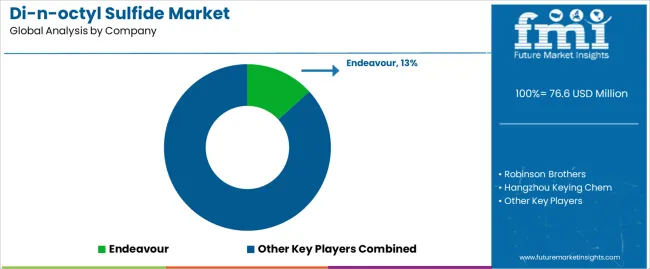
The Di-n-octyl sulfide market is characterized by competition among established chemical manufacturers, specialized synthesis producers, and integrated pharmaceutical solution companies. Companies are investing in precision manufacturing technologies, advanced purification systems, product innovation capabilities, and comprehensive distribution networks to deliver consistent, high-quality, and reliable Di-n-octyl sulfide systems. Innovation in purity enhancement, compatibility optimization, and application-specific product development is central to strengthening market position and customer satisfaction.
Endeavour leads the di-n-octyl sulfide market with a strong focus on chemical synthesis innovation and comprehensive Di-n-octyl sulfide solutions, offering commercial chemical systems with emphasis on manufacturing excellence and technological heritage. Robinson Brothers provides specialized synthesis chemicals with a focus on pharmaceutical market applications and performance engineering networks. Hangzhou Keying Chem delivers integrated chemical solutions with a focus on research positioning and operational efficiency.
The success of Di-n-octyl sulfide in meeting commercial synthesis demands, research-driven efficiency requirements, and performance integration will not only enhance synthesis quality outcomes but also strengthen global chemical manufacturing capabilities. It will consolidate emerging regions' positions as hubs for efficient chemical production and align advanced economies with commercial synthesis systems. This calls for a concerted effort by all stakeholders -- governments, industry bodies, manufacturers, distributors, and investors. Each can be a crucial enabler in preparing the di-n-octyl sulfide market for its next phase of growth.
How Governments Could Spur Local Production and Adoption?
How Industry Bodies Could Support Market Development?
How Distributors and Chemical Industry Players Could Strengthen the Ecosystem?
How Manufacturers Could Navigate the Shift?
| Items | Values |
|---|---|
| Quantitative Units (2025) | USD 76.6 Million |
| Purity Grade | High Purity Grade ≥97%, Standard Purity Grade <97%, Research Grade, Technical Grade |
| Application | Pharmaceutical Intermediates, Industrial Processing, Chemical Synthesis, Research Applications, Others |
| Synthesis Method | Direct Synthesis, Catalytic Synthesis, Modified Synthesis Processes |
| End-User Industry | Pharmaceutical Companies, Chemical Manufacturers, Research Institutions, Specialty Chemical Producers |
| Regions Covered | North America, Europe, Asia Pacific, Latin America, Middle East & Africa, Other Regions |
| Countries Covered | China, India, Germany, Brazil, United States, United Kingdom, Japan, and 40+ countries |
| Key Companies Profiled | Endeavour, Robinson Brothers, Hangzhou Keying Chem, and other leading Di-n-octyl sulfide companies |
| Additional Attributes | Dollar sales by purity grade, application, synthesis method, end-user industry, and region; regional demand trends, competitive landscape, technological advancements in chemical engineering, precision manufacturing initiatives, purification enhancement programs, and premium product development strategies |
The global Di-n-octyl sulfide market is estimated to be valued at USD 76.6 million in 2025.
The market size for the Di-n-octyl sulfide market is projected to reach USD 128.4 million by 2035.
The Di-n-octyl sulfide market is expected to grow at a 5.3% CAGR between 2025 and 2035.
The key product types in Di-n-octyl sulfide market are high purity grade ≥97% , standard purity grade <97%, research grade and technical grade.
In terms of application, pharmaceutical intermediates segment to command 67.0% share in the Di-n-octyl sulfide market in 2025.






Full Research Suite comprises of:
Market outlook & trends analysis
Interviews & case studies
Strategic recommendations
Vendor profiles & capabilities analysis
5-year forecasts
8 regions and 60+ country-level data splits
Market segment data splits
12 months of continuous data updates
DELIVERED AS:
PDF EXCEL ONLINE
Polysulfide Market Size and Share Forecast Outlook 2025 to 2035
Polysulfide Resin Market Growth & Demand 2025 to 2035
Carbon Disulfide Market - Trends & Analysis 2025 to 2035
Molybdenum Disulfide (MoS2) Crystal Market Size and Share Forecast Outlook 2025 to 2035
Molybdenum Disulfide Market
Polyphenylene Sulfide Market Size and Share Forecast Outlook 2025 to 2035
Polyphenylene Sulfide Resins Market
Demand for Polysulfide in EU Size and Share Forecast Outlook 2025 to 2035
Phosphorus Pentasulfide Market Demand & Growth 2025 to 2035

Thank you!
You will receive an email from our Business Development Manager. Please be sure to check your SPAM/JUNK folder too.
Chat With
MaRIA